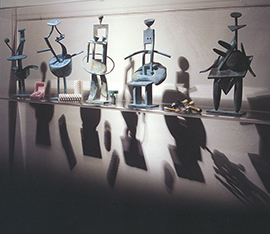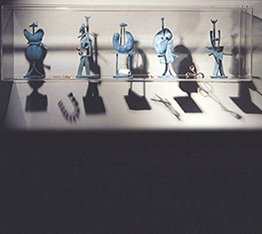If more proof is needed to establish the Seated Woman as signifying well-being we only need to remind ourselves of André Malraux’s recollection of Picasso’s words that, “it was also in order to ‘protect’ his women that he painted them comfortably seated in armchairs. His painting, he added, was not ‘innocent,’ it followed the example of black magic sculptures.” (Malraux 1976: 138). Paradoxically, Picasso is also quoted as claiming the opposite, that he sometimes depicted women in armchairs in order to berate them, which he literally did in the case of many of the seated portraits of his wife Olga (Fig.17, page 8) .
The poster for my Freud Museum, London, exhibition BURIAL placed Picasso’s Seated Woman, 1933, at the centre of a group of ancient sculptures that Sigmund Freud placed on his writing desk (Fig.37). I now realise that I intuitively recognised that the Seated Woman, in its bronze form, was akin to the other objects on Freud’s desk, all of which had been entombed as part of a ritual process designed to preserve, protect and most significantly—re-member. Now that I realise that the Seated Woman is Marie-Thérèse Minerva it makes this placement of her amongst this group even more poignant.
Une Anatomie in Sigmund Freud’s Bedroom
In the exhibition BURIAL at the Freud Museum, London, the bronze versions of the Anatomie drawings were exhibited in wall-mounted vitrines in a blacked out room that had once been Freud’s bedroom. Visitors to the room viewed the bronzes and the accompanying cosmetic items by means of small torches (Figs.38-39). The decision to exhibit them with cosmetic items normally associating with living women was driven by an intuitive desire to counteract their skeletal appearance and in so doing symbolically give them back life. (Fig.40). The 'giving back of life' is present in Picasso's first anatomy drawing in which two women with outstretched arms are greeting an ithyphallic male (Fig.41).
Fig.37 BURIAL, poster image, Freud Museum London, 1999, Sigmund Freud’s writing desk
Fig.38 Owen. Une Anatomie, 1995, bronze, Freud Museum, London, 1999.
Fig.39 Owen. Une Anatomie, 1995, bronze, Freud Museum, London, 1999.
Fig.40 Cosmetic items displayed with the Une Anatomie bronzes
 39
39 38
38